Kenneth L. Gentry Jr.'s Blog, page 46
May 14, 2021
NEW COVENANT CHURCH & OLD ISRAEL
 PMW 2021-039 by Kenneth L. Gentry, Jr.
PMW 2021-039 by Kenneth L. Gentry, Jr.
As noted on various occasions, I do try to answer questions sent in by my readers. I hope that these answers will be be helpful not only for the individuals who asked them, but for anyone who is interested in studying biblical eschatology. So, here goes today’s question:
Reader’s question:
Dispensationalists point out that God promises the new covenant to Israel only. The Jeremiah 31 text clearly mentions only “the house of Israel and the house of Judah.” How can we say that the new covenant finds fulfillment in the Church?
My response:
Thanks for your question. I hope the following brief answer will be helpful. First, please note that Jesus and Paul both apply the new covenant to the Church.
The Lord’s Supper is the sacrament of the new covenant that Christians take on a regular basis. Christ established the Lord’s Supper with these words: “And in the same way He took the cup after they had eaten, saying, ‘This cup which is poured out for you is the new covenant in My blood'” (Luke 22:20). Paul repeats this in his epistle to the Corinthians: “In the same way He took the cup also, after supper, saying, ‘This cup is the new covenant in My blood; do this, as often as you drink it, in remembrance of Me'” (1 Cor. 11:25).
Israel in the Bible and History (9 mp3 lectures)
Conference lectures highlighting the nature, call and identity of Israel.
Important rebuttal to dispensationalism.
See more study materials at: www.KennethGentry.com
Paul is the “apostle to the Gentiles” (Rom 11:13; 1 Tim 2:7), yet he claims that he is a servant of the “new covenant” (2 Cor 3:6). Obviously he sees the new covenant as including the Gentiles.
Second, you will find by reading the New Testament that the Church of Jesus Christ is the fruition of Israel. In fact, many Jewish descriptors are applied to the Church. We are the “seed of Abraham” (Rom 4:13–17; Gal 3:6–9, 29), “the circumcision” (Rom 2:28–29; Php 3:3; Col 2:11), “a royal priest-hood,” (Rom 15:16; 1Pe 2:9; Rev 1:6; 5:10; cp. Ex 19:6), “twelve tribes” (Jas 1:1), “diaspora” (1Pe 1:1), the “temple of God” (1Cor 3:16–17; 6:19; 2Cor 1:16; Eph 2:21). These terms clearly reflect Israel’s covenantal identity, yet they are applied to the Gentile Church.
Peter designates Christians as “stones” building up a “spiritual house” (1Pe 2:5–9). But he does more: he draws upon several Old Testament designations of Israel and applies them to the church. He calls Christians: “a chosen generation, a royal priesthood, an holy nation” (1Pe 2:9–10; Ex 19:5–6; Dt 7:6). He and Paul call Christians “a peculiar people” (1Pe 2:10; Tit 2:14), which is a familiar Old Testament designation for Israel (Ex 19:5; Dt 14:2; 26:18; Ps 135:4).
Thus, New Testament Christians may even call Abraham “our father” (Ro 4:16) and the old covenant people our “fathers” (1Co 10:1), clearly evincing a spiritual genealogical relation. Employing another figure, Paul says we are grafted into Israel (Rom 11:16–19) so that we become one with her, partaking of her promises (Eph 2:11–20). Jesus teaches that Gentiles are other sheep which must be brought in to make “one flock” (Jn 10:16).
Paul even applies the name “Israel” to Christians: “And as many as walk according to this rule, peace and mercy be upon them, and upon the Israel of God” (Gal 6:16). The “and [kai]” preceding “Israel of God,” is probably epexegetical, so that we should translate the passage: “mercy upon them, that is, upon the Israel of God.” Unfortunately, Dispensationalists see Galatians 6:16 applying to Jewish converts to Christ, “who would not oppose the apostle’s glorious message of salvation” (New Scofield Reference Bible). But such is surely not the case. After all, Galatians’ entire context opposes any claim to a special Jewish status or distinction: “For you are all sons of God through faith in Christ Jesus. For as many of you as were baptized into Christ have put on Christ. There is neither Jew nor Greek, there is neither slave nor free, there is neither male nor female; for you are all one in Christ Jesus” (Gal 3:26–28). In the new covenant Christ does away with all racial distinctions. Why would Paul hold out a special word for Jewish Christians (“the Israel of God”), when he states immediately beforehand that we must not boast at all, save in the cross of Christ (Gal 6:14)? After all, “in Christ Jesus neither circumcision nor uncircumcision avails anything, but a new creation” (Gal 6:15).
Consequently, Jeremiah’s mentioning the house of Israel and the house of Judah poses no difficulties for the New Testament writers. They apply Jewish terms to the Christian faith because it is the fulfillment of Israel.
Third, the dispensational system presents an unnecessary confusion here. Consider: By Christ’s appointment, the Lord’s Supper is the sign of the new covenant (Mt 26:28; Mk 14:24; Lk 22:20; 1Co 11:25). It is to be kept until he comes (1Co 11:25–26). But in dispensationalism, when Christ comes to establish the new covenant with Israel for a millennium, he will do away with the Lord’s Supper (which is the sign of the new covenant), while re-establishing the bloody sacrificial system (which is an old covenant foreshadowing of Christ’s redemptive labor, Heb 10:1–3) as a “memorial.” And the millennial priests will perform this memorial in Christ’s bodily presence for 1000 years.
Tongues-Speaking: Meaning, Purpose, and Cessation
(Book) by Ken Gentry
A careful study of the biblical material defining the gift of tongues.
Shows they were known languages that served to endorse the apostolic witness
and point to the coming destruction of Jerusalem, after which they ceased.
See more study materials at: www.KennethGentry.com
The new covenant is one of the key stumbling blocks for dispensationalism. As important as the new covenant is in Scripture, dispensational theologians have not been able to settle on a particular view of it. Charles Ryrie’s Basis of the Premillennial Faith outlines three leading dispensational views: (1) The Jews Only View. This is “the view that the new covenant directly concerns Israel and has no relationship to the Church” (p. 107). (2) The One Covenant/Two Aspects View: The one “new covenant has two aspects, one which applies to Israel, and one which applies to the church” (p. 107). (3) The Two New Covenants View. This is Ryrie’s view, for this actually “distinguishes the new covenant with Israel from the new covenant with the church. This view finds two new covenants in which the promises to Israel and the promises to the Church are more sharply distinguished even though both new covenants are based on the one sacrifice of Christ” (p. 107).
Oddly enough, today dispensationalists no longer hold to three views of the new covenant. They now have four views: “there are four major dispensational views of the new covenant” (Dictionary of Premillennial Theology, 280). The new covenant creates pandemonium in the dispensational system.
May 11, 2021
ZECHARIAH 14 IN POSTMILLENNIALISM (2)
 PMW 2021-038 by Kenneth L. Gentry, Jr.
PMW 2021-038 by Kenneth L. Gentry, Jr.
In my last article I began a two-part study on Zechariah 14. Having presented the dispensational view, I will now present a postmillennial interpretation of this famous passage.
The Siege of Jerusalem
The siege of Jerusalem described in Zechariah 14:1–2 points to the AD 70 judgment upon Jerusalem. J. Dwight Pentecost admits that the disciples who hear the Olivet Discourse would naturally apply Zechariah 14 to that event. But then, he says, such requires the confusing of God’s program for the church with that for Israel. So, he and other dispen-sationalists interpret the passage literalistically, with all the topographical and redemptive historical absurdities this creates. As they do this they totally omit any reference to the destruction of the very city and temple being rebuilt in Zechariah’s day. Yet this literal temple (the second temple) is destroyed in AD 70, as all agree.
Zechariah 14:1–2 pictures the Roman imperial forces joining the various client kings who engage the Jewish War AD 67–70. This war is conducted by an empire of “nations” (v 2), consisting not only of the Romans but the lands of Syria, Asia Minor, Palestine, Gaul, Egypt, Britain, and others. Client kings, such as Antiochus, Agrippa, Sohemus, Malchus, and Alexander, provide auxiliary forces for Rome during the Jewish War (J.W. 2:18:9; 3:4:2; 5:1:6). The consequences are disastrous: much of Israel’s population is either killed or led captive. D. A. Carson observes that never was “so high a percentage of a great city so thoroughly and painfully exterminated and enslaved as during the Fall of Jerusalem.” Yet the Lord defends those who are truly his people, insuring their escape from the besieged city (vv 3–4).
Great Tribulation: Past or Future?
(Thomas Ice v. Ken Gentry)
Debate book on the nature and timing of the great tribulation. Both sides thoroughly cover the evidence they deem necessary, then interact with each other.
See more study materials at: www.KennethGentry.com
The Lord will fight for his true people “as when he fought in the day of battle” (v 4). The Lord’s feet standing on the Mount of Olives and his fighting for his people need be no more literal than other references regarding the Lord’s fighting for Israel in the Old Testament. The language is similar to that in Joshua 10:14, 42 and 23:3, where the Lord “fought for Israel.” In Joshua these references indicate his providential favor in Israel’s victory and deliverance, not his corporeal presence. Prophecy often mentions God’s feet when his and Israel’s enemies are thwarted and are given success against all odds (Ps 18:9; Isa 60:13; Nah 1:3; Hab 3:5).
The Cleaving of Olivet
The cleaving of the Mount of Olives under him employs the common imagery of God’s conquering and restraining power in Old Testament prophecy. In Micah 1:3–4 we read that “the LORD is coming out of His place; He will come down and tread on the high places of the earth. The mountains will melt under him, and the valleys will split like wax before the fire, like waters poured down a steep place.” Even dispensationalists admit this speaks of the Old Testament subjugation of Israel under heathen nations for her sin. Mentioning the direction of the cleft “indicates the direction of their flight,” i.e., the Christians who flee Jerusalem when God judges it. They ultimately flee to all points of the compass, taking the gospel with them (cf. vv 8–9).
In the latter part of verse 5 the coming judgment upon Jerusalem, which disperses the Christians over the Roman Empire, is ultimately God’s coming in angelic judgment (“holy ones” are angels). Jerusalem’s destruction by Rome is providential destruction by “his armies” (Mt 22:7). It leads to darkness and woe upon Israel (Zec 14:6–7; cf. Ac 2:20, 22; Mt 24:29). Yet, as Jerusalem collapses and Christianity separates from her Jewish constraints, the waters of life begin flowing out into all the world (v 8; cp. Mt 24:14; Ac 1:8; 9:15). The Lord’s kingdom overflows Israel’s limited borders so that the he becomes the King of all the earth (v 9; Mt 28:18–19; Eph 1:20–21).
The subsequent topographical and liturgical references figuratively portray the ethical and spiritual changes that occur under Christ’s spir-itual administration as his worship spreads through the earth (vv 10ff). Even Jerusalem and the Jews shall be nourished by the waters of life eventually (vv 10–11; cf. Eze 47:1ff; Jn 7:38–39). The enemies of God’s people will either be vanquished (vv 12–13, 14), converted (vv 16, 20–21), or reduced to insignificance (vv 14, 17–19).
Getting the Message
(by Daniel Doriani)
Presents solid principles and clear examples of biblical interpretation.
See more study materials at: www.KennethGentry.com
The Feast of Tabernacles is mentioned, not as a literal reinstitution of the Old Testament feast, but as the ultimate hope pre-figured in that feast: the time of the full evangelical harvest (cf. Jn 4:35–38). Those who do not convert will be reduced to servile labors, lacking the blessing of God (vv 17–19).
Overall, however, the kingdom of God (represented here by a reju-venated Jerusalem, cp. Gal 4:25–26; Heb 12:22; Rev 21:2) will be spread throughout the earth. All areas of life will be consecrated to the Lord: even the horses’ bells will contain the inscription written on the High Priest’s miter (vv 20–21).
May 7, 2021
POSTMILLENNIALISM & ZECHARIAH 14 (1)
 PMW 2021-037 by Kenneth L. Gentry, Jr.
PMW 2021-037 by Kenneth L. Gentry, Jr.
In Zechariah’s great prophecy we read one verse that is used by dispensational literalists to overthrow the prophet’s postmillennial hope. That verse reads:
“And in that day His feet will stand on the Mount of Olives, which faces Jerusalem on the east. And the Mount of Olives shall be split in two, from east to west, making a very large valley; half of the mountain shall move toward the north and half of it toward the south.” (Zech 14:14)
ZECHARIAH ESCHATOLOGICAL DEBATE
Zechariah has been called “the most messianic, the most truly apocalyptic and eschatological of all the writings of the Old Testament” (ISBE1, 4:3136.) And surely it is. But Zechariah is greatly misunderstood in dispensationalism. Dispensationalists hold that Zechariah 14 undermines non-dispensational views such as postmillennialism. I will summarize the view from Dallas Seminary’s Bible Knowledge Commentary and then give a brief postmillennial interpretation of the passage.
That dispensationalists believe this prophecy undermines postmillennialism is evident in the following comment:
“Zechariah 14 progresses from the initial plundering of Jerusalem near the end of the future Tribulation, through the catastrophic judgment on the Gentile armies at Messiah’s Second Advent and the establishment of His millennial reign, to a description of the worship in Jerusalem during the Millennium. The fact that these events have not yet occurred points to a premillennial return of Christ, that is, His return before the Millennium.”
THE DISPENSATIONAL VIEW
Dispensationalists apply verse 1 to a great tribulation still in our future, which introduces the earthly millennial reign of Christ and comprises “the day of the Lord.” They see this verse as portraying the “military intervention of the Messiah,” with verse 4 detailing its accomplishment as the Lord descends upon the Mount of Olives (BKC 1:1570). Then he will establish his political kingdom over the earth, accompanied by “changes in illumination, climate, and topography which God will bring on Jerusalem, Palestine, and no doubt the whole earth during the Millennium” (1:1570). All of this arises from a literalistic reading of verses 6–11.
Three Views on the Millennium and Beyond
(ed. by Darrell Bock)
Presents three views on the millennium: progressive dispensationalist, amillennialist, and reconstructionist postmillennialist viewpoints. Includes separate responses to each view. Ken Gentry provides the postmillennial contribution.
See more study materials at: www.KennethGentry.com
Zechariah 14:12–15 supposedly is a “parenthetical flashback” describing “the second phase of the invasion of Jerusalem by the confederated Gentile armies.” After this, “the survivors from all the nations will worship annually in Jerusalem. ‘The survivors’ are not the Jewish remnant. . . [but are those] from nonmilitary personnel of those nations whose armies were destroyed by Messiah” (BKC 1:1570, 1571).
Verses 16–17 speak of “a newly instituted worldwide religious order embracing both Jews and Gentiles” that will be established and “will center in Jerusalem and will incorporate some features identical with or similar to certain aspects of Old Testament worship.” Thus, “worshiping annually in Jerusalem will be necessary for the people to enjoy the fertility of crops” (BKC 1:1570, 1571).
This entire dispensational scheme is wholly out of accord with the flow of redemptive history, so much so that it has been called an “evangelical heresy” by Meredith G. Kline. Indeed, “A. A. Hodge, B. B. Warfield, and J. G Machen . . . were outspoken opponents of dispensationalism, which they considered close to heresy.” Non-premillennial evangelicals vigorously denounce this interpretation. As redemptive history progresses to “the last days” (Isa 2:2–4; 1Co 10:11; Heb 9:26), which Christ institutes in the first century as the “fullness of time” (Mk 1:14–15; Gal 4:4; Heb 1:1–2), the entire temple order and sacrificial system is forever done away with (Mt 24:1–34; Heb 8:13; Rev 11). Accompanying the physical temple’s removal, divine worship is forever de-centralized and universalized (Jn 4:21–23; Mt 28:18–20). In addition, God merges the redeemed of all nations into one kingdom without ethnic distinction (Ro 11:13–24; Eph 2:12–21; Gal 6:12–16; Rev 7:9–10). This very much contradicts dispensationalism’s reversing the divine economy back to an old covenant-like order, complete with the elevating of the Jewish race over all peoples
Four Views on the Book of Revelation
(ed. by Marvin Pate)
Helpful presentation of four approaches to Revelation. Ken Gentry writes the chapter on the preterist approach to Revelation, which provides a 50 page survey of Revelation .
See more study materials at: www.KennethGentry.com
Of course, a major problem with the dispensational viewpoint here in Zechariah 14 is it’s a priori interpretive literalism. The postmillennialist would interpret the passage in a much different light. The whole passage — as often with prophecy — is a mingling of literal and figurative prophetic allusions, as we shall see. In my next posting.
May 4, 2021
REVELATION’S DIFFICULTY
 PMW 2021-036 by Kenneth L. Gentry, Jr.
PMW 2021-036 by Kenneth L. Gentry, Jr.
Evangelical laymen love to hear about the book of Revelation. Unfortunately, they tend to approach it as if it were a child’s toy. Many of contemporary dispensationalism’s best-sellers focus on Revelation. In a childish, shallow way.
We must recognize that even the trained, diligent scholar must approach Revelation with extreme caution, humbly recognizing that he is opening a book that has perplexed the finest minds and confounded the most godly saints throughout Christian history.
Gaius of Rome (d. 296) laments that “having formed an idea of it as a composition exceeding my capacity of understanding, I regard it as containing a kind of hidden and wonderful intelligence on the several subjects which come under it. For though I cannot comprehend it, I still suspect that there is some deeper sense underlying the words. And I do not measure and judge its expressions by the standard of my own reason, but, making more allowance for faith, I have simply regarded them as too lofty for my comprehension; and I do not forthwith reject what I do not understand, but I am only the more filled with wonder at it, in that I have not been able to discern its import” (Dion., Works 1:1:3).
Eusebius (AD ca. 260–340), the father of church history, notes that many declare it “unintelligible and illogical, and its title false” for it is not “an apocalypse (unveiling), since it is veiled by its heavy, thick curtain of unintelligibility” (Eccl. Hist. 7:25:1, 2). Cyril of Jerusalem (AD 315–86) forbade its public or private reading (Fiorenza 1991: 6). The great Latin church father Jerome (AD 340–420) laments in Epistle 53:8 that it contains “as many mysteries as it does words.” Methodius (d. AD 311) in his Symposium 8:9 mentions “the greatness of the mysteries of the text.”
[image error]For more information and to order click here." data-medium-file="https://postmillennialismtoday.files...." data-large-file="https://postmillennialismtoday.files...." class="wp-image-209" src="https://postmillennialismtoday.files...." alt="Navigating the Book of Revelation: Special Studies on Important Issues" />Navigating the Book of Revelation (by Ken Gentry)
Technical studies on key issues in Revelation, including the seven-sealed scroll, the cast out temple, Jewish persecution of Christianity, the Babylonian Harlot, and more.
See more study materials at: www.KennethGentry.com
Martin Luther (1483–1546), the famed Reformer and untiring interpreter of Scripture, originally rejects Rev as non-canonical, complaining, “My Spirit cannot adapt itself to the book.” In his German translation of the Bible, he complains in the preface to Rev that the book is “neither apostolic nor prophetic.” Fellow Reformer Ulrich Zwingli (1484–1531) refuses to take a doctrinal proof-text from Rev. In his Bern disputation he states: “I do not accept the witness of Revelation because it is not a biblical book.” Even John Calvin (1509–64) omits Rev from his prodigious commentary on the Bible — although he omits other books as well (2 John and 3 John).
John Wesley (1703–91) writes: “It is scarce possible for any that either love or fear God not to feel their hearts extremely affected in seriously reading either the beginning or the latter part of the Revelation. These, it is evident, we cannot consider too much; but the intermediate parts I did not study at all for many years; as utterly despairing of understanding them, after the fruitless attempts of so many wise and good men: and perhaps I should have lived and died in this sentiment, had I not seen the works of the great Bengelius. But these revived my hopes of understanding even the prophecies of this book; at least many of them in some good degree: for perhaps some will not be opened but in eternity.”
Adam Clarke (1762–1832): “I do not understand the book; and I am satisfied that no one who has written on the subject knows anything more of it than myself.”

The Book of Revelation Made Easy
(by Ken Gentry)
Helpful introduction to Revelation presenting keys for interpreting. Also provides studies of basic issues in Revelation’s story-line.|
See more study materials at: www.KennethGentry.com
R. H. Charles (1855–1931), in his ground-breaking commentary on Rev, states that it took him twenty-five years to complete (1: ix). Elsewhere Charles 1) reminds us that “school after school has essayed its interpretation, and school after school has in turn retired in failure from the task.”
Because of these difficulties, deistic radical Thomas Paine cleverly noted that Rev is “a book of riddles that requires a Revelation to explain it.” Ambrose Bierce bitingly defined “Revelation” in his Devil’s Dictionary: “A famous book in which St. John the Divine concealed all that he knew. The revealing is done by the commentators, who know nothing.” Chesterton captures the sentiment of many in this regard: “Though St. John the Evangelist saw many strange monsters in his vision, he saw no creature so wild as one of his own commentators.” South concurs: “The book called the Revelation, the more it is studied, the less it is understood, as generally either finding a man cracked, or making him so.”
Christians: Be careful with Revelation. It has confounded the minds of the greatest scholars. Sadly today the least scholars are monkeying around with it like it was a ripe banana.
April 30, 2021
LITERALISM AND POSTMILLENNIALISM
 PMW 2021-116 by Kenneth L. Gentry, Jr.
PMW 2021-116 by Kenneth L. Gentry, Jr.
From time-to-time, I am try to answer questions that readers send in. Here is one that I have received in a few different forms. I thought PMW readers might appreciate this brief Question and Answer.
Reader question:
I have a question for you. I recently heard a postmill/amill debate. The amill gave a criticism against postmill that I am really stuck on. Maybe you can help.
He said that postmills apply the restoration Psalms and prophecies like dispensationalists do, in a literalistic, types and shadows fashion. For example, regarding Psalm 2:8 the amill said that postmills apply the terms “nations” and “earth” in a way that Jesus and the apostles never intended (political entities, etc.). From his perspective, the NT teaches that for Christ to make the nations and earth His footstool refers to the salvation of the Gentiles from every tribe tongue and nation, not Christ’s influence on political structures, etc.
I think this is a good argument and I am a bit stumped. Can you help me?
J.B.
My reply:
Thanks for your question. I don’t see where the problem is in this critique of postmillennialism. I would note the following:
We must be careful not to throw out all literalism just because dispensationalists wrongly use it. Clearly many prophecies are to be interpreted literally. Perhaps the virgin birth is the best example of a literal prophecy — in that it involves one of the fundamentals of the faith by impacting the pre-existence and deity of Christ.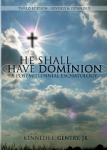
He Shall Have Dominion
(paperback by Kenneth Gentry)
A classic, thorough explanation and defense of postmillennialism (600+ pages). Complete with several chapters answering specific objections.
See more study materials at: www.KennethGentry.com
The Scriptures are not one-dimensional. They employ a variety of communicative forms and cover a broad range of literary types. We must check each text according to its context and its intended meaning.
Of course, the particular matter you bring up, does involve a particular text and context. You specifically mention Psalm 2:8. So here we have a concrete example, which is much better than an abstract principle.I don’t see the problem with using Psa 2:8 as evidence for postmillennialism. That is, I don’t understand what the issue of “political entities”/ “political structures” has to do with the amill/postmill debate here. Even setting aside the idea that particular political entities are in view here, the fact remains that the Psalm declares that Christ will make “the nations” (whatever they are) and “the very ends of the earth” his possession. He is not speaking merely of converts selected out from the nations, but the nations and the very ends of the earth themselves. The psalm appears to be speaking of some sort of global dominance. And of course this is expected in postmillennialism.
In addition, I would note that David calls upon the kings and judges of the earth to do homage to the Son (Psa 2:10-12). It seems he goes to great lengths to speak of not only people in general (nations and ends of the earth) but even their political rulers and judges. This leads me to believe that he does have nations as such in view. We surely do not believe that God has no interest in political structures and kingdoms.[image error]For more information and to order click here." data-medium-file="https://postmillennialismtoday.files...." data-large-file="https://postmillennialismtoday.files...." class="alignright size-thumbnail wp-image-209" src="https://postmillennialismtoday.files...." alt="Navigating the Book of Revelation: Special Studies on Important Issues" width="99" height="150">Navigating the Book of Revelation (by Ken Gentry)
Technical studies on key issues in Revelation, including the seven-sealed scroll, the cast out temple, Jewish persecution of Christianity, the Babylonian Harlot, and more.
See more study materials at: www.KennethGentry.com
Besides all of this, reducing the significance of Psa 2 would not affect the broader argument for postmillennialism. Postmillennialism is not a “one text” eschatological system (as premillennialism tends to be with Rev 20). We have a great number of texts from Genesis through Revelation that promote an optimistic view of the unfolding of history.For instance, my book He Shall Have Dominion: A Postmillennial Eschatology presents, defends, and promotes postmillennialism. It is over 600 pages long and covers texts from both testaments. Indeed, it employs scores of biblical texts. It would be greatly reduced in size if it were only dealing with verses that speak of national entities.
April 27, 2021
REVELATION AND DOUBLE FULFILLMENT
PMW 2021-108 by Kenneth L. Gentry, Jr.
I frequently have folks respond to my presentation of the preterist argument for Revelation in an unusual way. They see the strength of the preterist analysis of Revelation. They recognize that it is difficult to get around Revelation’s opening and closely comments regarding the temporal nearness of its prophecies. After all, Revelation 1:1 states rather clearly:
The Revelation of Jesus Christ, which God gave Him to show to His bond-servants, the things which must soon take place.
And Revelation 22:6 closes the book on the same note:
These words are faithful and true”; and the Lord, the God of the spirits of the prophets, sent His angel to show to His bond-servants the things which must soon take place.
Since these statements are so clear and compelling, some believers attempt an end-run around them. They agree that Revelation does in fact point to events that were to occur in John’s lifetime. But then they argue that these events can have double-fulfillment, so that they occur originally in the first century, but will occur again toward the end. For instance, Marvin Pate holds that Revelation “does not imply that Nero filled the complete expectation of the coming antichrist, but, as a precursor to such, he is certainly a good starting place.”[1]
Before Jerusalem Fell
(by Ken Gentry)
Doctoral dissertation defending a pre-AD 70 date for Revelation’s writing. Thoroughly covers internal evidence from Revelation, external evidence from history, and objections to the early date by scholars.
See more study materials at: www.KennethGentry.com
Three difficulties plague this type of response:
Lack of Exegetical Warrant
First, there is no exegetical warrant for double-fulfillment in Revelation. The statement is pure theological assertion. What is more, this approach not only empties John’s express declarations of meaning (“these things must shortly come to pass“), but it contravenes a specific angelic directive contrasting John’s responsibility to Daniel’s. An angel commands Daniel to “seal up” his prophecy for later times (Dan. 12:4), but commands John (who lives in “the last hour,” 1 John 2:18) to “not seal the words of the prophecy of this book, for the time is at hand” (Rev. 22:10).
Stretching of Intellectual Credulity
Second, the double-fulfillment argument requires us to believe that the many specific events, things, and personages of Revelation will appear repeatedly on the scene of earth history. In the same order? In the same geographic regions? With continual groupings of 144,000 being sealed? With constant beasts designated by the same number 666? On and on I could go. For example, Pate suggests that “the signs of the times began with Jesus and his generation,” and history witnesses “the coming intensification and culmination of those signs of the times” which begin in the first century.[2] Such a position seems to stretch credulity to the breaking point.
The already/not yet theological principle, though valid and widely accepted by evangelicals, cannot govern whole, vast, complex works such as Revelation. The already/not yet principle applies to unitary, simple constructs: the kingdom, salvation, new creation, and so forth. The principle snaps apart when we stretch it over so vast a work as Revelation. Furthermore, how can this principle explain the simultaneous operation in one book of such allegedly global themes operating as judgment (Rev. 6-19) and blessing (Rev. 20-22)? Pate’s use of this principle to explain Revelation seems more hopeful than helpful.[3]
Confusing Interpretation and Application
Third, this approach not only denies what John expressly affirms, but confuses principial application with original interpretation. That is, even were the events of Revelation repeated, that would not diminish the fact of their direct first century historical fulfillment — with all its pregnant meaning in that unique era which effects the closing of the sacrificial system, the setting aside of Israel, and the universalizing of the true faith. For instance, Exodus-like events occurring after the Mosaic Exodus do not remove the redemptive-historical significance of that original historical episode. Pate specifically notes the mark of the Beast “can be understood as pointing a guilty finger at those Jews in the first century.”[4] Why, then, should we look for further fulfillments beyond this most relevant first century one?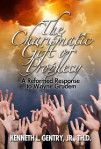
Charismatic Gift of Prophecy
(by Kenneth Gentry)
A rebuttal to charismatic arguments for the gift of prophecy continuing in the church today.
See more study materials at: www.KennethGentry.com
According to John, then, the prophetic events are “soon” (Rev. 1:1) and “at hand” (Rev. 1:3), so that his original audience must “hold fast” (Rev. 2:25; 3:11), waiting only “a little while longer” (Rev. 6:10). “I am coming soon. Hold on to what you have, so that no one will take your crown” (Rev. 3:11). The modern student of prophecy must not let his presupposed theological scheme or predetermined interpretive methodology blunt these forceful assertions.
Endnotes
C. Marvin Pate and Calvin B. Haines, Jr., Doomsday Delusions: What’s Wrong with Predictions About the End of the World (Downer’s Grove, Ill.: Inter-varsity, 1995),43-44.Pate and Haines, 36 (cp. 44, 57), 148-149. Emphasis added.Pate and Haines, 148-155.Pate and Haines, 53.April 25, 2021
AMILLENNIAL PESSIMISM
 PMW 2021-033 by Kenneth L. Gentry, Jr.
PMW 2021-033 by Kenneth L. Gentry, Jr.
Amillennialists often complain that postmillennialists wrongly categorize them as “pessimistic.” They generally reject this evaluation for two reasons: (1) It is negative sounding in itself. And (2) it overlooks the fact that they believe that ultimately Christ and his people win the victory at the end of history. Still other amillennialists deny this designation because they call themselves “optimistic amillennialists.”
What do postmillennialists mean by categorizing amillennialism as “pessimistic”? Is the charge legitimate. I believe it is.
Obviously all evangelical eschatological perspectives are ultimately optimistic — even dispensationalists who make a very nice living from books on cultural decline, despair, and doom. After all, Christ does lead his people to victory in saving them from their sins in history, resurrecting them from the dead at the end of history, and establishing them in righteousness in eternity. These issues are not debated among evangelicals: Christianity is of glorious, eternal consequence. But neither are these observations relevant to the debate between the millennial views.
The Truth about Postmillennialism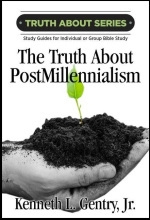 By Ken Gentry
By Ken Gentry
A group Bible study guide for explaining the optimistic prophetic hope for this world to be accomplished before Christ’s Second Coming. Establishes the postmillennial system in both the Old and New Testaments. Touches on key eschatological issues, such as creation, covenant, interpretive methodolgy, the great tribulation, the Book of Revelation, the Jewish Temple, and more. It presents and answers the leading objections to postmillennialism.Twelve chapters are ideal for one quarter of Sunday School.
See more study materials at: www.KennethGentry.com
Historically amillennialism has tended to be pessimistic in terms of the question of widespread, long-lasting cultural success for the Christian faith in time and on earth. That is, regarding these matters we should note:
First, as a system of gospel proclamation amillennialism teaches that the gospel of Christ will not exercise any majority influence in the world before Christ’s return. They allow that Christianity may enjoy flashes of revival and spurts of growth (e.g., the Reformation and the Great Awakening). Yet, by its very nature the amillennial system cannot allow that Christianity will become the dominant feature of human society and culture. Otherwise, it would actually be postmillennialism.
Second, as a system of historical understanding amillennialism, in fact, holds that the Bible teaches there are prophetically determined, irresistible trends downward toward chaos in the outworking and development of history. It is true that some amillennialists such as Jay E. Adams understand the great tribulation in the Olivet Discourse as referring (correctly) to the Jewish War and the AD 70 destruction of the temple. Yet their overall eschatological system necessarily demands a prophetically-determined collapse of society in history, as we can see in the writings of Jay Adams. Otherwise, it would actually be postmillennialism.
Thine Is the Kingdom
(ed. by Ken Gentry)
Contributors lay the scriptural foundation for a biblically-based, hope-filled postmillennial eschatology, while showing what it means to be postmillennial in the real world.
See more study materials at: www.KennethGentry.com
Third, as a system for the promotion of Christian discipleship amillennialism dissuades the Church from anticipating and laboring for wide-scale success in influencing the world for Christ during this age. It affirms the duty for churches to disciple converts, but it does not believe there will be enough converts to affect the direction of history. Otherwise, it would actually be postmillennialism. Regarding the question of so-called “optimistic amillennialists,” it seems to me that the verses an amillennialist would use to underscore his optimism are those that endorse a postmillennial perspective. Unless, of course, he is optimistic on grounds other than direct biblical revelation. Therefore, he should come out of the closet and be a postmillennialist.
April 20, 2021
THE GRADUALISM PRINCIPLE
 PMW 2021-032 by Kenneth L. Gentry, Jr.
PMW 2021-032 by Kenneth L. Gentry, Jr.
The principle of gradualism has long been the method of God and the experience of God’s people in Scripture. I will be showing below that if we are to properly understand Scripture’s eschatological victory, we must recognize this important redemptive-historical means of divine operation. In short, this principle expects the kingdom’s developmental unfolding and incremental expansion to grow slowly over time in the historical long run.
Contrary to postmillennialism, though, the dispensational and premillennial views operate on the basis of the principle of catastrophism. As premillennialist theologian Millard Erickson puts it: “Whereas the postmillennialist thinks that the millennium is being introduced gradually, perhaps almost imperceptibly, the premillennialist envisions a sudden, cataclysmic event.” [1] Dispensationalism believes that at Christ’s second advent “he will depose the earthly rulers and will begin His millennial reign.” [2] In their theological systems Christ’s kingdom with all of its attendant glory will invade history as a great catastrophe, being suddenly imposed on a recalcitrant world in remarkably brief period of time.
Theological Truths and Gradualism
A careful survey of Scripture suggests that gradualism is a common divine method of operation in history. Consider five clear samples:
Creation. Even God’s creating the universe proceeds upon a gradualistic principle — an accelerated gradualism, to be sure, but gradualism nonetheless. God creates the world out of nothing, but he does not create it as a complete system by one divine command — though he could easily do so. He employs a series of successive divine commands that stretch out over a period of six days (Gen 1; Exo 20:11).

Greatness of the Great Commission (by Ken Gentry)
An insightful analysis of the full implications of the great commission. Impacts postmillennialism as well as the whole Christian worldview.
See more study materials at: www.KennethGentry.com
Though God places Adam in the Garden of Eden with a command to cultivate the soil there (Gen 2:15), he expects Adam to begin working the implications of the Cultural Mandate into all the world (Gen 1:26–28). Chung notes that “Adam’s rule was anticipated to be extended to the entire creation beyond the boundary of the garden of Eden.” [3] This obviously requires a long, slow process.
Redemption. God promises redemption just after sin enters into the human race in Eden (Gen 3:15). Yet its accomplishment follows thousands of years after Adam, when Christ finally comes “in the fulness of time” (Gal 4:4; Eph 1:10).
Revelation. Rather than giving his total special revelation all at once, God gradually unfolds his word to men over a period of 1,500 years (Heb 1:1, 2; 1Pe 1:10–12).
Sanctification. Even in salvation, justification, which is a once-for-all act (Rom 4:2–3; 5:1), gives rise to sanctification, which comes by process (Php 2:12–13; 1Pe 2:2).
The Kingdom and Gradualism
Now we must note that God’s redemptive kingdom also develops gradualistically. It incrementally unfolds through history, progressing from small, imperceptible beginnings to a glorious, dominant, worldwide conclusion. I will survey several relevant passages illustrating this important principle.
An historical indicator of kingdom gradualism appears in the Promised Land’s conquest. In Deuteronomy 7:22 we read: “And the Lord your God will clear away these nations before you little by little; you will not be able to put an end to them quickly, lest the wild beasts grow too numerous for you.” Here Moses specifically informs Israel that gradual conquest is for her good, allowing her people to conquer where they could secure and maintain control.
In Daniel 2:31–45 Christ’s kingdom comes down to earth as a stone smiting the world kingdom, which exists under a fourth imperial rule. As we read through the passage we learn that the kingdom grows to become a great mountain in the earth:
“You watched while a stone was cut out without hands, which struck the image on its feet of iron and clay, and broke them in pieces . . . . And the stone that struck the image became a great mountain and filled the whole earth. And in the days of these kings the God of heaven will set up a kingdom which shall never be destroyed; and the kingdom shall not be left to other people; it shall break in pieces and consume all these kingdoms, and it shall stand forever.” (Dan 2:34–35, 44)
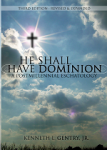
He Shall Have Dominion
(paperback by Kenneth Gentry)
A classic, thorough explanation and defense of postmillennialism (600+ pages). Complete with several chapters answering specific objections.
See more study materials at: www.KennethGentry.com
In this imagery we have both linear continuity over time and upward development: the stone grows to become a “great mountain.” We also witness struggle and resistance: the stone smashes the image. Finally, we rejoice in its fortunes: the God-defying image is thoroughly crushed.
In Ezekiel 17:22–24 God promises to establish the kingdom as a small “sprig from the lofty top of the cedar.” Then he will nurture it until it becomes “a stately cedar.” Ultimately, it will produce great boughs so that “birds of every kind will nest under it.” This growth is certain for “I am the LORD; I have spoken, and I will perform it.”
In Ezekiel 47:1–9 redemption flows forth from God’s temple as an ever-deepening stream. The waters of life trickle from under the altar, first “to the ankles” (Eze 47:3), then they flow gradually deeper to the knees (Eze 47:4a), then deeper still to the loins (Eze 47:4b), until the stream finally becomes “a river that I could not ford” (Eze 47:5). This is the river of life (Eze 47:9). In fact, in John 7:38 Christ presents himself as fulfilling this prophecy. This water-from-the-altar is quite consistent with Christ’s presenting himself as the true temple (John 2:19–21). In John 7:38 we read: “He who believes in Me, as the Scripture has said, out of his heart will flow rivers of living water.” At Pentecost the torrential flow of the living water begins in earnest (Acts 2:33).
In Matthew 13 the Kingdom Parables speak of the kingdom’s growing increase in external size and transformational influence (see Ch. 3 above). Matthew 13:3–9 portrays the kingdom as scattered seed that gradually grows to bear abundant fruit. Matthew 13:31–33 likens the kingdom’s external growth to a mustard seed which becomes a great plant and its internal penetration working like a little leaven leavening three bushels of meal. In Mark 4 God’s kingdom begins as mere seed (Mark 4:26), then it puts forth the blade, then the head, the mature grain (Mark 4:27–28).
In Romans and 1 John the apostles see the kingdom light as already shining, ready to dispel the darkness:
“The night is almost gone, and the day is at hand. Let us therefore lay aside the deeds of darkness and put on the armor of light.” (Rom 13:12)
“On the other hand, I am writing a new commandment to you, which is true in Him and in you, because the darkness is passing away, and the true light is already shining.” (1 John 2:8)
Satan will not be able to thwart the kingdom’s progress and growth, for the “gates of Hades will not be able to prevail against it” (Matt 16:18). Though slow, it will advance in God’s good time.
By the way, the Already/Not Yet Principle is also involved in the Gradualism Principle. I will be dealing with that in an upcoming post. So, though I have “Already” decided to write this article, I have “Not Yet” done so. But it is established in principle. Hang on!
Notes
Millard J. Erickson, Christian Theology (1998), 1217.Bobby Hayes, “Premillennialism,” Dictionary of Premillennial Theology, 311.Chung in Blomberg and Chung, Historic Premillennialism, 139.April 16, 2021
MY FAVORITE POSTMILLENNIAL VERSES
 PMW 2021-031 by Kenneth L. Gentry, Jr.
PMW 2021-031 by Kenneth L. Gentry, Jr.
I became a postmillennialist after becoming dismayed with dispensationalism, while studying at Grace Theological seminary. But I did not leap from dispensational despair to postmillennial progress in a single bound. Nor was my move faster than a speeding bullet. Nor did I deem it necessary to wear a red cape to do this. (I’ll see how many of you watched Superman on TV in the 1950s.)
Eschatological journey
I was converted in a dispensational ministry: my dispensationalist uncle’s church in Chattanooga, Tennessee. Then I enrolled in Tennessee Temple College, a fundamentalist Baptist operated school, where I secured a B.A. in Biblical Studies. Now armed-and-dangerous with dispensational proof-texts, I set sail to Grace Theological Seminary in Winona Lake, Indiana. There I was being trained in a higher level, more scholarly version of dispensationalism.
But something did not click for me. I began seeing problems with the system, and longed for something less complicated, more clear, and more biblical. In the GTS library I stumbled upon O. T. Allis’s Prophecy and the Church. And that did it. I raptured out of dispensationalism. And never looked back (except to pick up my hat — it was snowing that day).
Rather than jumping into postmillennialism, by default I stopped off at amillennialism for about a year while in seminary. This was the final few months of my enrollment at Grace Theological Seminary and the first few of my classes at Reformed Theological Seminary in Jackson, Mississippi.
I have often called amillennialism the “parking lot” of eschatology. It is a comfortable place to get away from the eschatological debate and the heavy traffic it generates when you have “no particular place to go” (pardon me, Chuck Berry). As an amill you are not in a fast lane going north or going south. You are just sitting there conserving energy (and dreaming that one day you too may be Dutch).
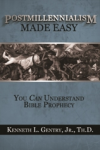
Postmillennialism Made Easy (by Ken Gentry)
Basic introduction to postmillennialism. Presents the essence of the postmillennial argument and answers the leading objections. And all in a succinct, introductory fashion.
See more study materials at: www.KennethGentry.com
Yet while at Reformed Seminary, I took a class called “Eschatology and History” which was taught by Dr. Greg L. Bahnsen. He was not Dr. Bahnsen then though. He was Joe Cleveland. Just kidding. He was in process of getting his doctorate, so he did not have his Ph.D. yet. He was simply “Mr. Bahnsen.” (But his doctorate did not bestow enormous intelligence on him. He already had it, which allowed him to take all of his Ph.D. exit exams in just one week!)
Through the first few weeks of the class I resisted him. I “kicked against the goads,” you might say. But Bahnsen could be very persuasive, bringing pretty big goads against you. He was armed with a great command of the Bible and theology, as well as keen skills in logical persuasion. (And he would often throw in a little rhetoric, just for fun.) Before the semester was out: I had overhauled the ole Gentrymobile, exited the amill parking lot, and entered into the postmillennial fast lane to the future. And the rest, as they say, is aluminum foil. (Well, not many people say, that. Most will say “the rest is history,” but I like to mix things up a bit.)
Bahnsen persuaded me with his double-barreled, whole-Bible approach to eschatology. He did not load mainly from the Old Testament, nor mainly from the New Testament. He was interested in showing what the whole Bible has to say about eschatology. And the whole Bible, he argued, is postmillennial in its orientation and character.
Leading verses
Now the question arises: What verses were most influential in persuading me? Just to pick two passages from each testament, I would say in the Old Testament Psalm 72 and Isaiah 2 greatly impacted my thinking. Then in the New Testament the Kingdom Parables (Matt 13//) and the great commission (Matt 28:18-20) did the trick.
The Truth about Postmillennialism By Ken Gentry
By Ken Gentry
A group Bible study guide for explaining the optimistic prophetic hope for this world to be accomplished before Christ’s Second Coming. Establishes the postmillennial system in both the Old and New Testaments. Touches on key eschatological issues, such as creation, covenant, interpretive methodolgy, the great tribulation, the Book of Revelation, the Jewish Temple, and more. It presents and answers the leading objections to postmillennialism.Twelve chapters are ideal for one quarter of Sunday School.
See more study materials at: www.KennethGentry.com
In Psalm 72 we learn of Christ’s ruling “from the River to the ends of the earth” (Psa 72:8). And we learn that this will occur before the consummational conflagration (2 Pet 3:10-12) that produces the new heavens and new earth, because he will reign “till the moon is no more” (Psa 72:7).
In Isaiah 2 we see that God’s righteousness and peace will come with the exaltation of his kingdom “in the last days” (Isa 2:2). That is, during the last days we will witness “many peoples” streaming into the kingdom of God where they will taught God’s ways (Isa 2:2-3). Then eventually this will issue forth in worldwide peace (Isa 2:4).
This is the foundation to the New Testament hope, which Jesus promoted — and taught his disciples. In the Kingdom Parables we see that the kingdom will grow incrementally to world dominance (Matt 13:31–33).
The Old Testament hope is also the spark that leads Jesus to give his great commission. In that commissioning Jesus calls his small flock to “disciple the nations” so that they might be baptized and learn to observe all things he teaches us (Matt 28:18–20).
These are not the only verses that lead to the postmillennial hope. In fact, it was hard to reduce my “favorite” postmillennial passages to just two Old Testament and two New Testament passages. My book He Shall Have Dominion: A Postmillennial Eschatology has over 600 pages and deals with hundreds of verses.
Interested request
But now, I wonder: What verses were most influential in leading you to postmillennialism? I would love to hear from you.
April 13, 2021
PERSECUTION AND POSTMILLENNIALISM
PMW 2021-030 by Kenneth L. Gentry, Jr.
Critics of postmillennialism will often turn to negative sounding passages in the New Testament in order to discredit any postmillennialism optimism regarding the future.
For instance, Matthew 10:23 is a favorite in this regard:
“You will be hated by all because of My name, but it is the one who has endured to the end who will be saved.”
Since postmillennialism expects a future in which Christianity reigns supreme, and in which righteousness and peace will prevail throughout the world, texts such as this one must be explained. Postmillennialism cannot be true if Christians will always be hated and the only hope we have is our bare endurance.
But does this passage teach such? I do not believe that it does. We must read the verse in its context to grasp what our Lord is actually declaring.

Three Views on the Millennium and Beyond (ed. by Darrell Bock)
Presents three views on the millennium: progressive dispensationalist, amillennialist, and reconstructionist postmillennialist viewpoints. Includes separate responses to each view. Ken Gentry provides the postmillennial contribution.
See more study materials at: www.KennethGentry.com
In Matt 10 Jesus appoints his disciples as apostles, investing them with great authority (Matt 10:1–2). And at this stage of his ministry he limits their outreach to Israel alone: “These twelve Jesus sent out after instructing them: ‘Do not go in the way of the Gentiles, and do not enter any city of the Samaritans; but rather go to the lost sheep of the house of Israel’” (Matt 10:5–6). Of course, this is not the way it was always to be, for later at the end of his ministry he commissions his church to “make disciples of all the nations” (Matt 28:19).
Furthermore, immediately after his limiting their mission to Israel, he teaches them what they are to preach: “And as you go, preach, saying, ‘The kingdom of heaven is at hand’” (Matt 10:7). This also shows the early phase of his ministry. The kingdom has not yet come, though it is close at hand.
He then directs them to go from city-to-city in Israel to preach the gospel, heal the sick, cast out demons, and so forth (Matt 10:8–15). He notes that he is sending them “as sheep in the midst of wolves” (Matt 10:16). And in doing so he warns them: “But beware of men, for they will hand you over to the courts and scourge you in their synagogues; and you will even be brought before governors and kings for My sake, as a testimony to them and to the Gentiles” (Matt 10:17–18). This clearly speaks of their ministry to Israel, for it mentions the trouble they will experience from the synagogues.
He further warns that “brother will betray brother to death, and a father his child; and children will rise up against parents and cause them to be put to death” (Matt 10:21). Then we read the verse that raised our question: “You will be hated by all because of My name, but it is the one who has endured to the end who will be saved” (Matt 10:22).
Then following this warning he promises: “But whenever they persecute you in one city, flee to the next; for truly I say to you, you will not finish going through the cities of Israel until the Son of Man comes” (Matt 10:23). We must ask: “Whenever who persecutes you?” Contextually, it is speaking expressly of Jewish opposition.
What Matt 10:22 is declaring then is that as his twelve disciples (who are all dead by now!) engage the mission to Israel, they must hang tough, they must endure through the raging of Israel against Christ and his followers. Not only so, but he promises he will come in judgment against Israel before they have finished going through all the cities of Israel. This refers to the AD 70 destruction of Jerusalem and the temple, the specific “end” in view.
A similar statement to Matt 10:22 is found in Matt 24:13: “But the one who endures to the end, he will be saved.” And again, the context points to the time preceding the fall of Jerusalem, for he is answering a question about the coming destruction of the temple (Matt 24:2–3).
Thus, Matt 10:22 (and Matt 24:13) do not speak of relentless persecution to the end of history (are you persecuted to death?). Rather it is referring to Jewish persecution of the Christian faith that leads up to AD 70.

The Harrowing of Hell (by Jay Rogers)
This postmillennial book examines the power of the Gospel, not only to overcome all opposition, but to rise far above the powers of hell. The term “Harrowing of Hell” refers to idea that Christ descended into Hell, as stated in the Apostles’ Creed.
For more Christian educational materials: www.KennethGentry.com
Kenneth L. Gentry Jr.'s Blog
- Kenneth L. Gentry Jr.'s profile
- 85 followers



